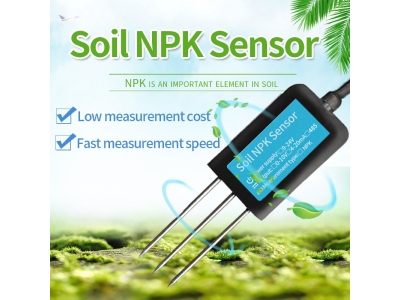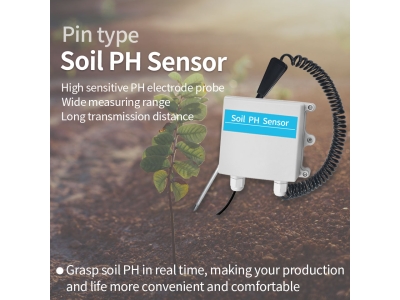Agriculture is a vital sector that sustains human life by providing food, feed, and fiber. With the global population projected to reach 9.7 billion by 2050, there is a growing need to optimize agricultural practices for increased productivity and sustainability. Soil health plays a crucial role in crop growth and yield, making it essential to monitor and manage soil conditions effectively. This article explores how soil sensor technology can unlock the potential of agriculture by providing real-time data on soil parameters, enabling farmers to make informed decisions and optimize their farming practices.
Understanding Soil Sensor Technology
Soil sensor technology involves the use of electronic devices that measure various parameters in the soil, such as moisture content, temperature, nutrient levels, pH, and salinity. These sensors are embedded in the soil or placed at different depths, allowing continuous monitoring of soil conditions. The collected data is then transmitted wirelessly to a central system, where it is processed and analyzed to provide actionable insights to farmers.

Monitoring Soil Moisture
One of the critical factors affecting crop growth is soil moisture. Soil sensors can accurately measure soil moisture content at different depths and locations within a field. This information helps farmers implement efficient irrigation strategies by enabling them to apply water precisely when and where it is needed. By avoiding over-irrigation, water usage can be optimized, reducing costs and minimizing the environmental impact.
Optimizing Nutrient Management
Proper nutrient management is essential for maximizing crop yield while minimizing nutrient wastage. Soil sensors can measure nutrient levels in the soil, providing farmers with valuable information on the availability of essential elements like nitrogen, phosphorus, and potassium. By having real-time data on nutrient levels, farmers can adjust fertilizer application rates and timing, ensuring optimal nutrient uptake by crops. This not only improves productivity but also reduces the risk of nutrient runoff and groundwater contamination.
Assessing Soil pH and Salinity
Soil pH and salinity levels significantly influence crop health and productivity. Soil sensors can accurately measure these parameters, allowing farmers to identify areas with imbalanced pH or salinity levels. With this information, corrective measures can be taken, such as applying soil amendments or implementing proper drainage systems, to restore optimal soil conditions. By maintaining the correct pH and salinity levels, crops can thrive and achieve their full potential.
Monitoring Soil Temperature
Soil temperature is a crucial factor affecting seed germination, root development, and nutrient availability. Soil sensors can provide real-time data on soil temperature, allowing farmers to make informed decisions regarding planting times and crop selection. By ensuring the soil temperature is within the optimal range for specific crops, farmers can enhance germination rates, promote healthy root development, and improve overall crop performance.
Implementing Precision Agriculture
The integration of soil sensor technology with other precision agriculture tools, such as GPS and remote sensing, allows for the implementation of customized farming practices. By collecting and analyzing data from soil sensors, farmers can create detailed soil maps that highlight variations in soil properties across a field. This enables site-specific management, where inputs like water, fertilizers, and pesticides can be applied at precise locations and rates, optimizing resource utilization and reducing environmental impact.
Enhancing Data-Driven Decision Making
The data collected from soil sensors provides valuable insights for farmers to make data-driven decisions. By monitoring and analyzing soil parameters over time, farmers can identify trends and patterns that help them understand the unique characteristics of their farms. This knowledge allows for proactive management strategies, such as adjusting irrigation schedules based on predicted weather conditions or implementing variable rate application of nutrients tailored to specific soil zones. These decisions lead to improved efficiency, reduced costs, and ultimately, increased agricultural productivity.
Challenges and Future Directions
While soil sensor technology has immense potential, there are several challenges that need to be addressed. Cost can be a deterrent for widespread adoption, as soil sensor systems can be expensive, especially for small-scale farmers. Furthermore, data management and analysis can be complex, requiring specialized knowledge and infrastructure. To overcome these challenges, efforts should be made to make soil sensor technology more affordable and user-friendly, and provide farmers with the necessary training and support.
Looking ahead, advancements in sensor technology, data analytics, and connectivity will further enhance the capabilities of soil sensors. Integration with artificial intelligence and machine learning algorithms will enable predictive modeling, allowing farmers to anticipate soil conditions and optimize farming practices accordingly. Additionally, the development of wireless networks and Internet of Things (IoT) technology will facilitate seamless data transmission and real-time monitoring on a larger scale.
Conclusion
Soil sensor technology has the potential to revolutionize agriculture by providing farmers with real-time data on soil parameters. By monitoring soil moisture, nutrient levels, pH, salinity, and temperature, farmers can make informed decisions and implement precision agriculture practices. This leads to optimized resource utilization, increased agricultural productivity, and improved environmental sustainability. Efforts should be made to overcome challenges and promote the adoption of soil sensor technology, ensuring its benefits are realized across diverse farming systems worldwide. With ongoing advancements, the future of agriculture looks promising, unlocking its full potential with soil sensor technology.






